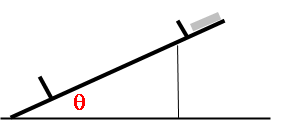Work in your groups and furnish complete, well written group solution to the following
problems. This is a timed exercise - you have 45 minutes to complete each task (including the write-up). You may "bank time" - ie: if you finish one task early you may use the remainig time on an other task. The lab will end at 4:15 sharp!
-
Explain how we can measure static coefficients of friction and derive an expression that relates the static coefficient of friction of an object on an incline to the angle of inclination. Do this with the apparatus set up at the front of the lab and illustrated in the drawing shown below. What is the static coefficient of friction for the plastic block - aluminum track used in this exercise? Express your value with an appropriate error measure (+/-).
|
- What does it mean when we say an object has reached its "terminal velocity"?
- Draw a free body diagram for a falling body and derive an expression for terminal velocity. Use your expression to predict the terminal velocity of a basket type coffee filter of mass 0.0015 kg, effective radius 7 cm and drag coefficient C = 0.80.
- Next, measure the terminal velocity for a falling coffee filter by analyzing the following video clip. This shows a video of a falling coffee filter (vertical scale:height of clip = 1.0 m). Explain how you used this data to measure the terminal velocity. How well did your prediction match the measured velocity.
|
- A nylon block will be released on an aluminum incline similar to the one shown on the right. In a previous question you determined the coefficient of static friction for the block. This time a photogate has been set up that will give you a very precise timing of the block as it slides along the incline. Derive an expression for the acceleration of the block and then use this to derive an expression for the kinetic coefficient of friction. Your expression should look something like the one for the static case but with an important "correction term". Argue how this and the equipment available could be used to measure the coefficient of kinetic friction. Do this and report your value for "mu-kinetic". NOTE! Three is a smal wrinkle - tha apparatus will tell you the final speed of the nylon block - not its acceleration! You will need to figure out how to use this information.
|
 |
